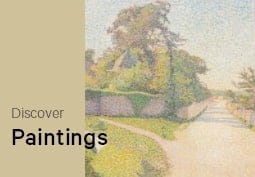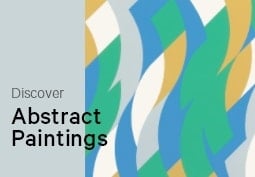Articles and Features
Top 10 Landscape Artists in Modern and Contemporary Art
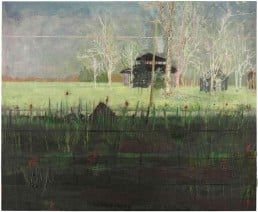
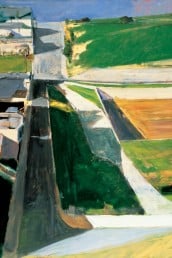
Courtesy San Francisco Museum of Modern Art
1. Richard Diebenkorn
Richard Diebenkorn was a post-war American artist most widely associated with the Bay Area movement of San Francisco, a group of artists in the early 1960s who ruffled the feathers of the dominant abstract expressionist generation by returning to a figurative mode of painting. Diebenkorn had spent time on the East Coast where he primarily explored abstraction in his work. However, as he returned West and stripped away from his practice what he derided as a highly rule based and programmatic approach to abstraction he returned to California’s landscape topography as his principal subject. He used the shapes and colors of the Northern California landscape as a structural framework for his paintings; gridded structures, aerial-like vantage points and a visible delight in imbuing the materiality of his paint with the unique light of the region. Diebenkorn’s blustery, highly abstract canvases are landscapes by feeling and suggestion.

© The David Hockney Foundation
2. David Hockney
No survey of the landscape in modern and contemporary art would be complete without David Hockney. However, this British artist, transplanted to California, has come a long a way from his famous Malibu and Santa Monica poolscapes of the 1960s and 1970s. Beginning his artistic career at The Royal College of Art in the late 1950s and early 1960s Hockney’s working life has been closely associated with the pop art movements and also with painterly expressionism. He has experimented widely with various methodologies for making landscape works, including watercolours, photo collages, monumental compositions consisting of multiple smaller canvases made outdoors and then assembled inside, and even works made with the assistance of software and iPads. Inextricably associated with the sunshine of Southern California, Hockney has also made landscape works of The Grand Canyon, the South of France, and in recent years extensively of the countryside in Yorkshire, the county from which he originated in Northern England.
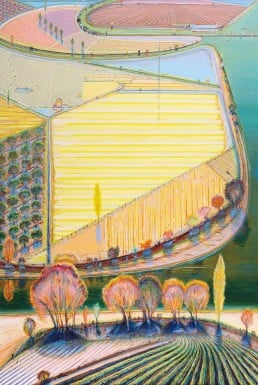
72 x 48 inches, Collection of Matthew Bult, © Wayne Thiebaud
3. Wayne Thiebaud
Often understood as a West Coast pop artist, Thiebaud has become synonymous with his deceptively simple and colourful still life studies of objects from the 1960s, especially the food, objects and table arrangements of archetypal American diner life. Thiebaud began producing landscapes in the 1960s, employing his characteristic exaggerated candy-coloured palette and fastidious painterly technique while experimenting with vertiginous perspective to capture his Californian surroundings. Landscape presented Thiebaud with an opportunity to explore formal questions, not necessarily the specifics of the places he depicted. “The attempt is to express as effectively as I can a sense of equilibrium and disequilibrium, so that they are somewhat discomforting. Painting is a dead flat object and when you’re trying to get some tension, majesty, or ominousness, something has to happen within that structure, to entice people to it with their bodies physically, to experience it.”
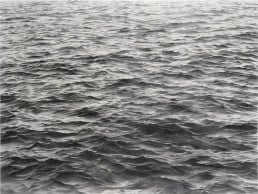
4. Vija Celmins
Vija Celmins is a Latvian American artist who has long been celebrated for her meticulous renderings of natural imagery, including ocean waves, desert floors, and night skies. Her paintings, sculptures, drawings, and prints depict scenes that are overwhelming in their infinite detail. Celmins first became interested in representing the visible world during the early 1960s, when she began to paint the objects in her Los Angeles studio. In 1961 she won a Fellowship to attend a Summer session at Yale University, where she met Chuck Close and Brice Marden, who would remain close friends. It was during this time she began to study Italian still life painter Giorgio Morandi, which influenced the simplicity of subject matter she depicted as well as the reduced tonality. By the end of the 1960s, when she first developed her all-over compositions of waves, rocks, and celestial bodies, she had set aside paint in favour of graphite and charcoal. Using photographs as a source material, she uses a muted grey photorealistic technique, focusing on the object quality of the finished work, as opposed to the subject matter of it. It is as if the infinite extension of the landscape implied by the image’s ‘cropped’ appearance can only be comprehended when held captive by a modestly scaled object. Distilling vast, expansive distances into mesmerizing, small-scale artworks, these “redescriptions” are a way to understand human consciousness in relation to lived experience.
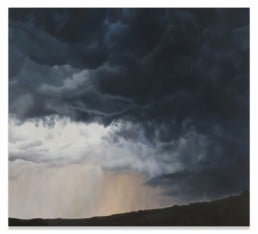
5. April Gornik
April Gornik is a landscape artist who paints monumental canvases showing the majesty of the American landscape. Linked to the objectives of historical groups like the Hudson River School painters, Gornik also seeks to show the power of nature and the feelings of the sublime it evokes in the viewer. Her works are often heavily focused on cloud formations. “Now I make my landscapes so that I can be in them,” the artist has remarked. “That’s why I alter them, that’s why I make them somewhat artificial, because I want to take possession of them.” Even though she is not an environmental activist with her work per se, she is a passionate nature lover and believes deeply in its spiritual power. She has said that “If someone interprets my work as being a protest against our destructive behavior, or an attempt to get people to look outside themselves or see themselves as part of nature rather than having an anthropocentric view, I’m happy to have encouraged that”.
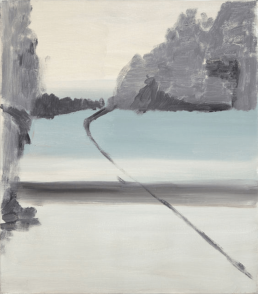
6. Ilse d'Hollander
Ilse D’Hollander’s intimately scaled paintings exhibit a highly developed sense of colour, composition, scale and surface, most often through the use of subtly subdued tones and simple pared-down compositions. Many of her works favour a kind of lyrical abstraction imbued with a reflective tone, but an almost equal number allude to physical spaces and landscape, especially the broad earthy expanses of the Flemish landscape near her home. Considered a true artists’ artist, she was a painter with incredible deftness of touch. Her canvases and works on paper often favor abstraction, yet subtly allude to the everyday, hinting at nature and the landscape of the Flemish countryside where she spent the last and most productive years of her life. However, while alluding to objects and places in the world, as well as specifics of temperature and light, D’Hollander’s paintings are seldom immediately recognisable as straightforward or literal landscapes. The viewer is drawn in close, as much by the ambiguity of image as the intimate scale which also invites scrutiny. Monochrome or near monochrome fields might be interrupted by blocks of colour; geometric volumes softened by streaks of paint or scumbled marks – applied with a brush or sometimes the artist’s hands. The results can be read as a series of accumulated impressions, adjustments and layerings within her judiciously pared-back compositions – the artist’s thought processes memorialised and recorded by the making of the work.
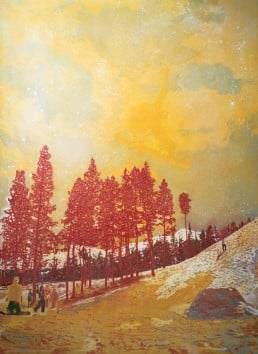
7. Peter Doig
Peter Doig is a Scottish born artist, who as a child moved first to the Caribbean and then to Canada, where he grew up. His works evoke a strange and ambiguous narrative, often with a cloying or foreboding atmosphere. Often described as possessing of a ‘magical realism’, the works are rendered from photographs, not to replicate the precision of the photographic image but to reference elements of memory and record. In a 2008 interview, Doig referred to his use of photographs and postcards as painting “by proxy” and noted that his paintings “made no attempt to reflect setting”. Many of Doig’s paintings are landscapes, somewhat abstract, with a number harking back to the snowy scenes of his childhood in Canada. He draws inspiration for his figurative work from various photographic sources; newspaper clippings, movie scenes, record album covers and the work of earlier artists like Edvard Munch, whose works can be described as attempts to convey a profound psychological state. His landscapes are layered formally and conceptually, and draw on assorted art historical artists, including Caspar David Friedrich, Claude Monet and Gustav Klimt.
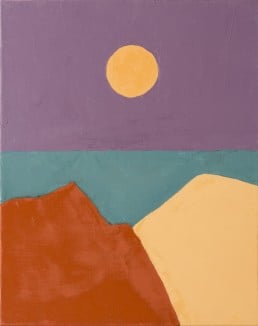
8. Etel Adnan
Etel Adnan is a Lebanese-American poet, essayist, and visual artist. In 2003, Adnan was named “arguably the most celebrated and accomplished Arab American author writing today” by the academic journal MELUS: Multi-Ethnic Literature of the United States. Since around 1950 she has been based in California, where she has worked for most of her adult life as an academic. In recent years, and relatively late in life she has gained worldwide acclaim for her paintings. Color and light are the two dynamics that inform Adnan’s ongoing series of landscape paintings of Mount Tamalpais (Marin County, California). Adnan has said that “light is everything for me,” and the sunlight expressed in her paintings and other works is often stylised and shown as the main compositional motif. Known as an outstanding colonist, Adnan’s paintings are deceptively simple yet highly sophisticated essays in harmonious composition.
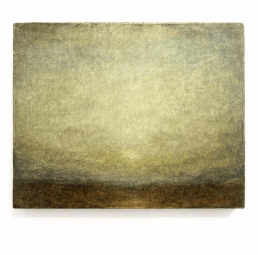
9. Lucas Arruda
Lucas Arruda is a Brazilian contemporary painter known for the highly atmospheric luminosity of his paintings. Perceived as landscapes, his evocative paintings are more a product of a state of mind than depictions of particular locales. As he has noted, “The only reason to call my works landscapes is cultural—it’s simply that viewers automatically register my format as a landscape, although none of the images can be traced to a geographic location. It’s the idea of landscape as a structure, rather than a real place.” Arruda’s landscapes and seascapes are characterised by their subtly modulated light conditions. Painted from memory, they are devoid of specific reference points, achieving instead their variety through the depiction of various types of atmospheric glow, recalling perhaps differing weathers, times of day, or even seasons. Verging on abstraction, the compositions are grounded by an ever-present, if sometimes faintly perceptible, horizon line that offers a sense of distance and the implication of perspectival or atmospheric space. Intimately sized, they appear at once familiar and imaginary. Through his lightly textured brushstrokes, Arruda brings the materiality and physicality of his paint to the fore, while also recalling the genres’ historical associations with the romantic sublime.
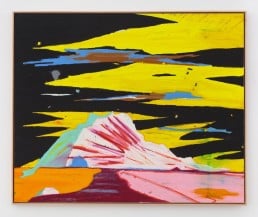
10. Harold Ancart
Harold Ancart is a Belgian artist based in New York City. Known for his bold colour and strong compositions, stylistically some of which bear a passing resemblance to the abstract expressionist works of Clyfford Still. Many of his works are landscape paintings, although Ancart himself has described his subjects as pretexts for exploring more formal painterly concerns. In Ancart’s landscape works the horizon line is expansive and the space implied vast, even though the irreducible qualities of painting, and of drawing, have long been his driving motivation. Ancart has pared down his imagery to elemental forms while amplifying scale and tonality. Clouds, fires, icebergs, and the elements of land mass and water are the identifiable shapes he uses to strip landscape painting down to its rudiments. The artist has described subject matter as an “alibi” for the paint to be pushed onto the canvas. Ancart creates radiant compositions that recall key moments in modernist painting, especially abstract expressionism and color field painting, extending their delicate minimalism into an exuberant vision. In his work he recognises a delirious longing for a kind of utopian place or Eden-like escape as a constant feature of our imaginations, and it is this fictitious domain he often seeks to represent. In his paintings he posits that the possibilities for transformative experience are not just somehow out in the world to strive for, but contained within the arena of painting.
